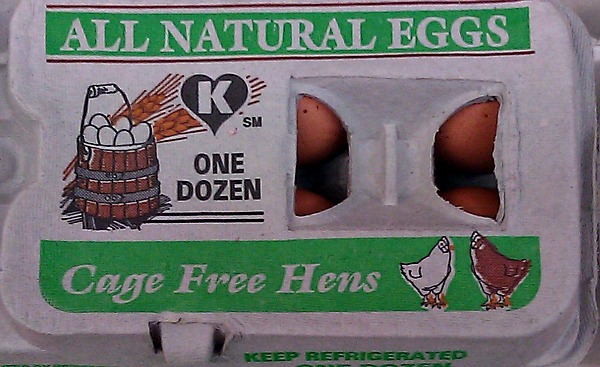 Meat and eggs labeled as “free range” or “cage free” have become increasingly popular in recent years as consumers try to source higher quality food for their families as well as to vote with their food dollars for humane and “green” conditions for the chickens themselves.
Meat and eggs labeled as “free range” or “cage free” have become increasingly popular in recent years as consumers try to source higher quality food for their families as well as to vote with their food dollars for humane and “green” conditions for the chickens themselves.
When most people think of free range, cage free chickens, they get a picture in their mind of happy chickens outdoors in the open air, completely free to express their chicken-ness by clucking around and pecking in the dirt for grubs and insects.
The truth of the matter is something else entirely. In fact, one of the more popular posts on the Healthy Home Economist Facebook page recently was a picture of the actual living conditions of free range, cage free chickens.
After seeing this Facebook post, Susan O. a reader who rescues “free range” chickens from commercial operations, sent me a series of shocking photos. Here are the photos along with her description of what these poor chickens endured, which turns out to be not much better than regular battery hens in cages.
Susan’s own words describing the 3 rescued “free range” hens – at only 1 year old:
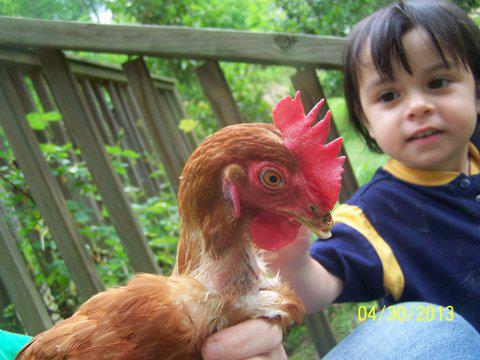
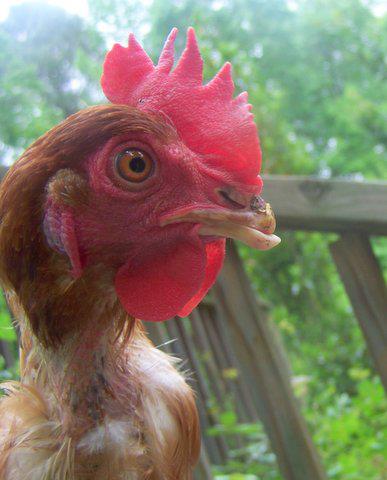
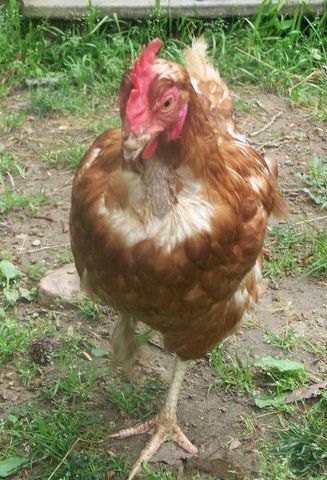
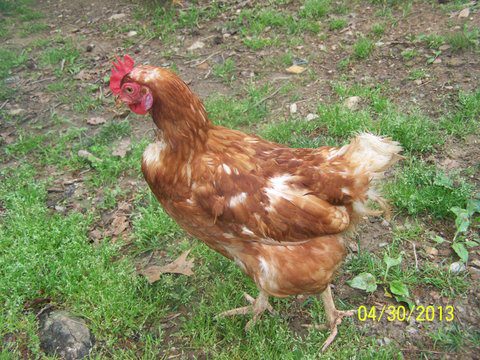
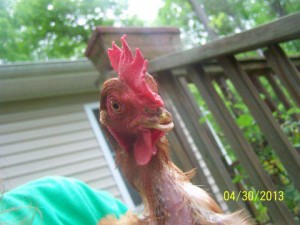
We “rescued” 3 hens from a commercial supplier who had one year old spent hens they wanted to sell. Their breed is Isa Brown.
The eggs were sold as “free-range” and “cage-free”.
We had no direct contact with the main supplier. It was very difficult to get the hens. Another person who purchases mass amounts of the hens from the egg supplier for $1.00 each was tracked down and he agreed to sell them to a group of rescuers for $10.00 each.
We’ve had these hens for a little over a month and they look much better then they used to. These photos were taken last week. When they arrived they were in much worse shape.
They’d never been outside, had no idea how to act like chickens. They wouldn’t roost at night, just pecked and walked around all night long.
I suspect their “house” was kept lit almost 24 hours a day for greater egg production. They pecked EVERYTHING. Trees, plastic, metal.
They were clueless. I had to cut their toenails. They were over an inch long!
One was limping her toenails were so long. They all had hen mites. All have feather loss. The combs on their heads were not the color they are now, but very pale, a sign of anemia and malnourishment.
The red fleshy part near the ear area was white and is still a little white today. Their eggs were without shells, had only a membrane on the outside from extreme calcium deficiency.
Another rescuer said her hen laid an egg and it broke inside her. They’ve also had their beaks cut. These hens will need to be on a special diet. They can’t crack corn or seeds with their beaks or pick up regular feed that’s not crumbled.
It’s like removing a human’s four front teeth and telling them to eat. They’ve learned to become very efficient at grabbing worms out of our compost bin. They are very gentle animals. We can pick all of them up and pet them.
People need to understand that the meat industry sees an animal as simply a product, to be used until they’re spent, then discarded like trash. The last thing the industry is worried about is our health and providing us with nutritious food.
We have a small homestead and do raise chickens and rabbits for meat, but these rescued ladies have a “free pass” to enjoy being chickens for as long as they live.
When friends shake their head and say “I couldn’t do it ” when I tell them about raising animals for meat, I draw the comparison between my healthy hens and these poor rescue hens.
If these “cage-free” hens were in this bad of shape at only one year old, I shiver to think how bad a typical battery hen would be. And no doubt, the gentleman gave us the better looking hens. Not everyone can afford pastured meat (but we manage, even on a budget 200% of the federal poverty guidelines and without taking any government assistance ), but pastured eggs can be afforded by most.
What Does a Healthy Chicken Actually Look Like?
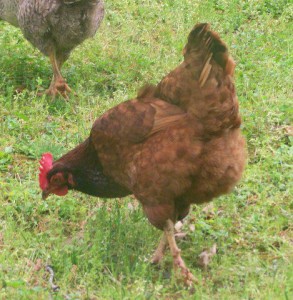 This is a photo of one of Susan’s long-time yard hens. She’s a comparable breed to the Isa Brown. She’s been truly free range since the day she was born.
This is a photo of one of Susan’s long-time yard hens. She’s a comparable breed to the Isa Brown. She’s been truly free range since the day she was born.
Note the tremendous difference between the two, “cage free” store label hen vs truly free range hen. No missing beak, feathers, white spots or mite infestation. The happy chicken is focused on the ground, pecking for insects and grubs instead of the pathetic, sad, vacant stare that signifies the horrifying animal abuse endured by chickens whose meat and eggs are labeled “free range” at the store.
In order not to be fooled into thinking your chicken and eggs come from happy birds like this one to the right when they actually come from beakless, anemic, mite ridden animals that have been so abused they can’t even peck in the dirt or crack corn, resolve to buy local!
When you buy from a neighbor or small scale local farmer who raises chickens, you can see them for yourself and note their health by the living conditions.
Abdicating responsibility for knowing exactly where your food comes from by trusting meaningless food labels in a store that proclaim eggs or meat as “free range” or “cage free” is not helping to secure quality food for your family nor is it helping to promote the cause of humane conditions for farm animals.
Sarah, The Healthy Home Economist







Free Range is important but we must not forget the other half of the equasion, “organic”. In our area there are several local farmers selling free range eggs and they are truly free ranging chickens doing in pastures what chickens do best. However, these are small farmers and there is not always enough “natural” food so their food is supplemented with chicken feed. The farmers I have personally talked to use chicken regular off the shelf chicken feed from the local feed store. As one told me they use “whatever is cheap” because feeding the chickens gets expensive.
What that says to me is that the chickens are being fed GMO corn, soy and lots of other chemical laden grains. Not an appitizing thought.
Solution: Look for eggs labeld Free Range, Organic and with a statement on the carton that they are “collected from small farms” or something to that affect (indicating they are not from an single source ‘egg factory’). We find such eggs in several stores and they come from either PA or CA. No their not as fresh as local eggs but they are a lot healthier.
I’m scared to look.
My landlords rescued ten hens who were also kept “cage free” . They look much worse, very pale, thin and naked. They are better now but I´m afraid they will never fully recover.
This is why we are raising our own “egg” chickens…you even have to be careful when you buy “meat” chickens as chicks…they are genetically modified no matter what you feed them. (I’m learning way too much up here
ALL commercial eggs in the grocery store come from bad conditions and poor food. Most are 45 days old when you get them. Find a local source for your eggs. They keep for a long time, so you can buy a month’s supply at the time. They don’t need to be refrigerated–just kept cool. Also, there is now commercial soy-free food for chickens, so ask about that as well. An egg is, literally, a miracle, if the hen is healthy. It has the perfect balance of fat to protein, lots of good choline (needed for brain development for babies), etc., etc. Eggs are an extremely important food.
We are ranchers who have been ranching in our community for over 130 years as a family. We began a farm share program just so families can SEE how their meals are being raised/fed. We are warning everyone to take a drive, find a farmer who has chickens running free all over, grass in the pastures that he manages and drive in the yard and talk to him. The truth is the small family farmer is being run out of business. We can no longer hire help or ship or products, so we get help from those who buy their food from us. We teach them how to milk the cows, collect eggs, build fences to keep the goats in, irrigate etc. Many hands make light work.
Another great article and another reason to support your local farmer! Thanks, Sarah.
I recently purchased 3 6-month-old laying hens from a local “farmer” on Craigslist. $5 each. When I got there I found a dirty, stinky “farm” that was really a few trailers with outbuildings. Thousands of chickens were kept under one hoop house fenced in at the ends. There was one roost that I could see. All had pale combs & wattles and were missing all feathers on their butts. When I got them home, I discovered they also had mites and possibly worms. They didn’t lay for weeks except for one membranous egg – no shell. Now 2 of 3 lay regularly.
The farmhand told me it was a free-range egg operation and I couldn’t help thinking about all the poor malnourished chickens and the people being duped at the local farmers market 🙁
Noooo! This is depressing. I have wasted my extra dollars with images of happy hens frolicking in grassy hills. Buying local is the way to go.
I am an omnivore, but really, we need to not support methods of animal raising that treats them like this. Even animals raised for food need to be respected as the living beings with feelings that they are.